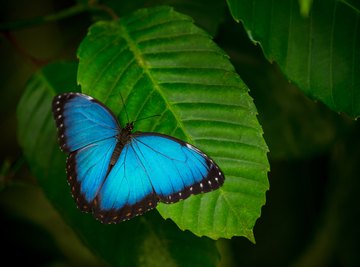
Butterfly adaptations are the behaviors or physical features that help the insect survive in its environment. Blue morpho butterflies are well-adapted to their tropical forest habitats, having both behavioral and structural adaptations that allow them to feed, avoid predators and eventually reproduce. These adaptations are evident at all stages of the blue morpho's life cycle, from an egg through to a mature adult.
Description
Within the butterfly family known as Nymphalidae, there are approximately 30 species and many more subspecies of morpho butterflies, all native to Mexico, Central America or South America. Morpho species are large butterflies, some with a wingspan of over 8 inches (200 mm).
They are easily distinguished by their iridescent blue wings, with males generally more vividly colored than females. The morpho is often called a butterfly with eyes on its wings. Their eyes are on their head, like all butterflies, but the underside of their wings is gray and brown with patterns forming large eyespots.
Immature Adaptations
The three stages of development (egg, larva and pupa) before the blue morpho reaches its recognizable adult form are all adapted to survival. The pale green egg color naturally blends in with the leaf on which it was laid. This adaptive coloring of the egg, which won't hatch for one to two weeks, helps it to avoid predation from birds and other insects.
The larval form, or caterpillar, of the blue morpho has a striking appearance. Patches of bright yellow/green are interspersed by patches of purple and large tufts of hair. It is thought that this form breaks up the typical shape of a larva, making it less obvious as a target of insect-eating animals. The hairs on the caterpillar are irritating to potential predators, who learn to avoid larvae with this physical adaptation.
A blue morpho butterfly in the pupal, or chrysalis, stage is highly vulnerable to predators as it is immobile. At this stage, it has turned back to a pale or dark green color so that it can blend in easily with its leafy surroundings. It takes a couple of weeks for the pupa to become an adult and the color adaptation helps it camouflage while it is transforming.
Adult Butterfly Adaptations
Having brilliant blue wings might seem like a liability as they would make the butterfly highly visible to predators. But these bright wings, when flashed, can also act to startle an animal. The underside of those wings also protects the insect.
When butterflies are at rest, they fold their wings up over their bodies. When a blue morpho does this, the obvious eyespots and brownish coloring are visible, not the iridescent blue. This structural adaptation deters or frightens animals that may otherwise threaten the butterfly.
Behavioral Adaptations
It isn't just the physical or structural adaptations that allow the blue morpho to live in its environment. Some of its behaviors, including its food choices and its flight activities, help to ensure its survival. As larvae, some morpho species can be cannibalistic, ensuring their survival when food is scarce or there are too many caterpillars competing with each other for food.
Generally, blue morpho larvae feed on a number of different plant species including several species of legume. This varied diet ensures that if one plant is scarce, there will be others just as suitable. Like the monarch butterfly's diet of poisonous milkweed, some morpho caterpillars ingest poisonous plants, making them inedible.
A further behavior of the larva is its ability to release a noxious oil. When disturbed, the larva secretes a distasteful and foul-smelling substance that prevents animals, including parasitic insects, from harming it.
Butterfly adaptations in the behavior of adults also help with survival. Blue morpho adults are considered erratic and powerful flyers, making them difficult for predators to catch. They feed on a wide variety of rotting fruits and tree sap. This variation in its feeding behavior allows the blue morpho to easily find food within its tropical forest habitat.
References
- University of Florida IFAS: Featured Creatures: Blue Morpho Butterfly
- Tropical Lepidoptera: Life Histories of Neo Tropical Butterflies From Trinidad
- Florida State University: Molecular Expressions: Butterfly Wing Scale Digital Image Gallery: Blue Morpho Butterfly
- The University of the West Indies at St. Augustine: The Online Guide to the Animals of Trinidad and Tobago
- Tropical Lepidoptera: Natural History, Immature Stages and Hostplants of Morpho Amathonte From Western Columbia
- The Natural History Museum: Spotlight: The Blue Morpho
Resources
About the Author
Ms. Jean Godawa is a former science educator and freelance writer with a degree in biology and environmental science. She is fascinated by insects, and conducted field research in the rainforests of South America and South East Asia. She contributes science and nature articles to online and print publications including ONNature, Trellis and The Globe and Mail.
